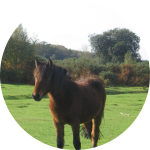|
Horse Stall contains all types of information for Horse Lovers.
There are a number of products branded horse gifts and products.
All gifts have a unique horse design that horse lovers and pony
owners will appreciate. Branded items include: t-shirts, sweatshirts,
sneakers, posters, skateboards, mouse pads, stickers, bumper stickers,
buttons, mugs, tote bags, invitations, greeting cards, neckties,
postcards, posters, prints and much more!
Horse Articles :: Horse Tack
Horse Tack
|
|
If you are going to look after horses, you need to understand
their tack.
Colors - Stable colors are frequently displayed on brow bands,
blankets and coolers.
Order of Predence - When tacking a horse, he should first
be bridled and then saddled; when removing tack, generally
the girth should be loosened and the stirrups run up on the
saddle - then remove the bridle and replace it with a halter.
Removing the saddle last avoids the sudden release of pressure
on the horse's back.
The Saddle - The pommel is the raised forward part. The cantle
is the raised rear part. The tree is a form over which the
saddle is built. Generally, it is made of wood with metal
reinforcement, but frequently, it is made of light solid metal.
The skirts are the small pieces of leather near the pommel
covering the stirrup bars. The flaps are the large pieces
of leather covering the girth buckles.
The weight of an adult's English (flat) saddle with girth,
stirrup leathers and irons, is approximately 15 to 18 pounds.
Saddles vary considerably depending on their use. They are
usually specially designed for the following purposes: general
riding, polo, hunting, jumping, the show ring, military, flat
racing, cattle work (the western or stock saddle which weighs
from 30 to 40 pounds without silver).
Girths - There are several types of girth: A folded leather
girth is most usual. A balding girth is one composed of three
interlaced straps, providing freedom at the horse's elbows.
A Fitzwilliam girth is one with a thinner strap superimposed
on the larger main girth. A Lonsdale girth is shaped so that
it is narrow at the horse's elbows and is reinforced with
a thinner superimposed strap stitched to the main girth.
A canvas girth is used largely on saddle horses. A string
girth is used when a horse is tender or has just recovered
from girth sores. It is frequently used regularly by military
and police organizations. An overgirth is an elastic web surcingle
passing over the saddle and under the horse's belly. It is
used in addition to the regular girth, generally in racing,
to assure the security of the saddle.
Stirrups - Stirrups are generally made of metal, although,
for western riding, they are generally made of wood with leather
wrappings on the tread in leather hoods. Metal stirrups are
made in various sizes and weights - the widest about 52 inches.
Metal stirrups are frequently canted toward the rear and hung
off center to assist in the natural placement of the foot
with heels down and toes pointing slightly upward and outward.
Stirrups on flat (English) saddles are frequently referred
to as "irons."
Bridle - The bridle is usually composed of a crown piece,
cheek straps, throat latch, brow band, bit, cavesson (nose
band) and one or two reins. If a curb chain is used on a bit,
it is held in place along the horse's chin groove by a thin
piece of leather known as a lip strap.
The bit may be attached to the bridle by a sewn-in leather
loop, by buckles or by hook billets (metal fasteners in the
shape of hooks).
Bits - Bits are usually made entirely of metal, but frequently
the portion in the horse's mouth is made of hard rubber. Bits
are generally classified as: curb (or bit), snaffle (or bridoon),
pelham or double (bit and bridoon or curb and snaffle).
A bit is a single bar in a horse's mouth with shanks, and
a curb chain to provide leverage, controlled by a single rein.
A snaffle is a single bar (sometimes jointed) without a shank,
controlled by a single rein. A pelham is a single bar with
a shank and a curb chain controlled by two reins. A double
bit is two separate bits - the snaffle (bridoon) and the curb
(bit).
When the bridle is placed on the horse, the following should
be checked for proper adjustment:
A. the bit - regulated by the cheek straps; B. curb chain;
C. throat latch; and D., if used, the cavesson (nose band).
Now you know about horses' tack, you will be able to take
better care of your horse.isfactory standard of show jumping.
About the Author
Discover Everything You've Ever Wanted to Know About Horse
Training - You'll Be http://www.freehorsetraining.com/
|
|
|


